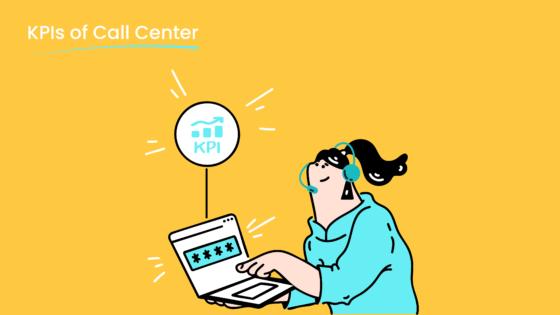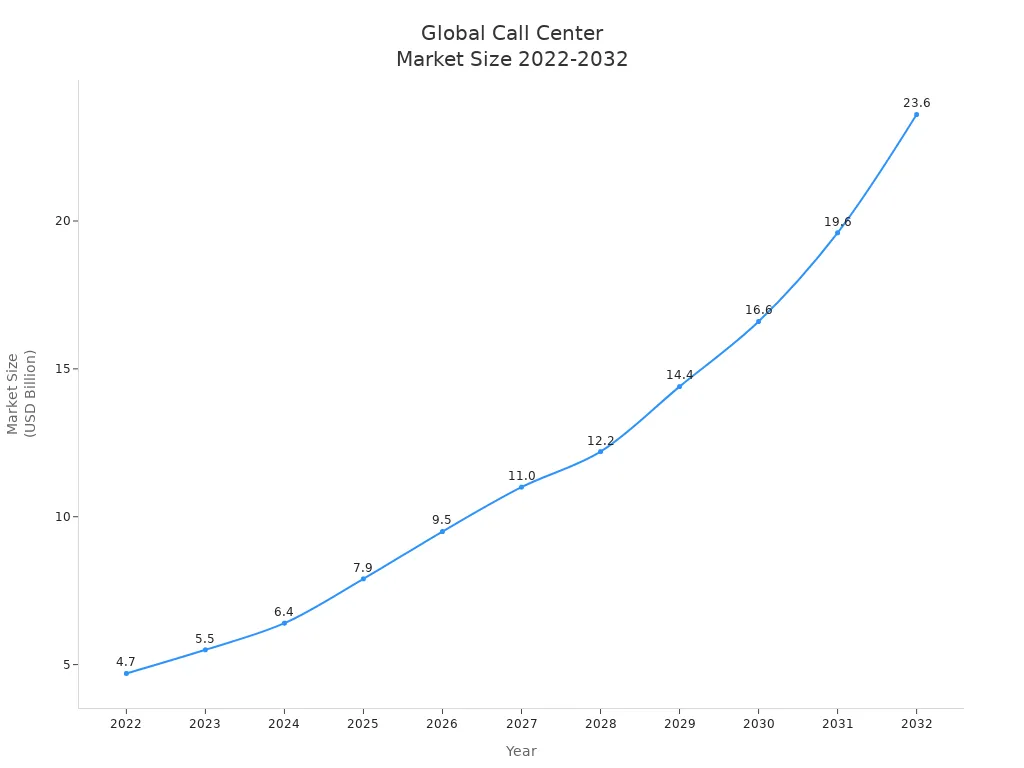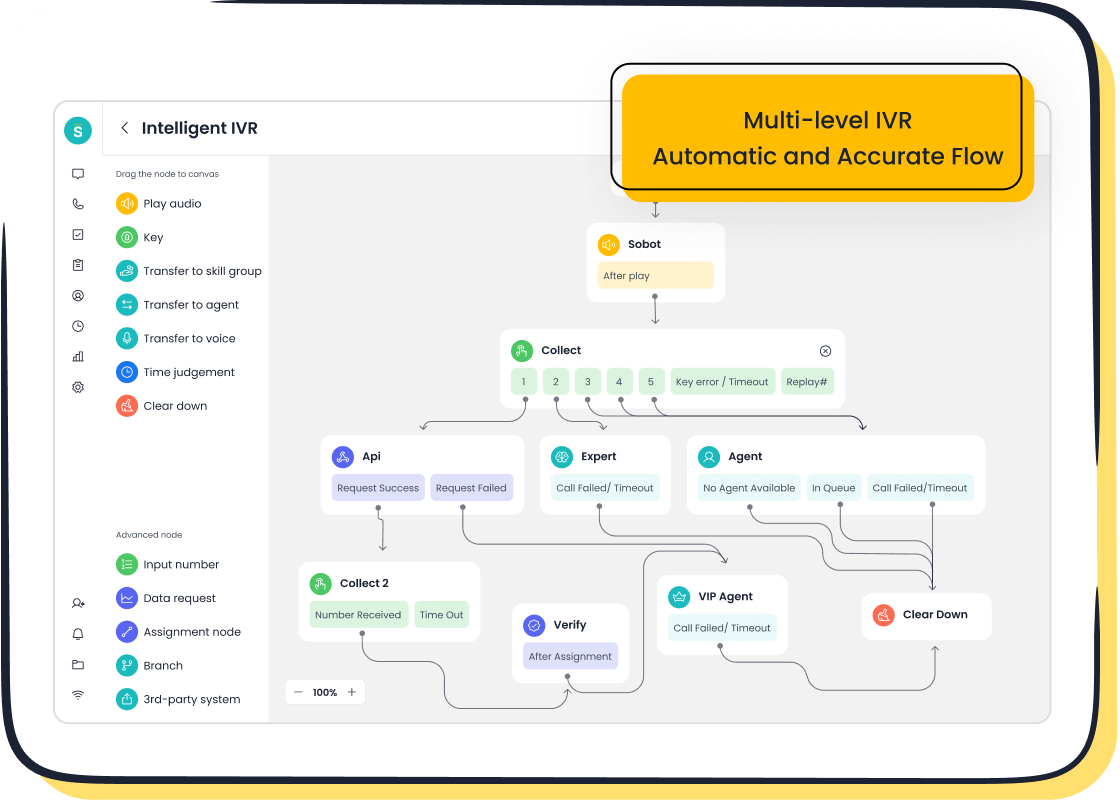How to Choose the Right Call Center Solution Provider in 2025

Are you searching for the right call center solution provider in 2025? The market keeps growing every year. Take a look at this chart showing the global call center solutions market rising from $4.7 billion in 2022 to $7.9 billion in 2025:

You want a call center solution provider that matches your goals, uses advanced technology like Sobot AI, and offers strong support. The right call center partner should fit your business needs, scale up as you grow, and keep your data safe. Sobot call center stands out when you need a solution that handles change and supports your team. Focus on practical evaluation. Don’t just look at features or price—think about finding the right call center partner for your future.
Define Your Needs

Before you start searching for a call center solution provider, you need to get clear about your needs. Every business is different, so your goals, customer base, and communication style will shape your decision. Let’s break down what you should consider.
Service Goals
What do you want your call center to achieve? Maybe you want to boost customer satisfaction, handle more sales calls, or support users across multiple languages. Your needs might include faster response times, higher first-contact resolution, or better agent productivity. If you want to unify sales, marketing, and support, look for a provider that can help you reach those goals. Write down your top priorities. This list will guide your search and help you compare options.
Tip: If you want to improve customer loyalty, focus on solutions that offer personalized service and easy integration with your existing systems.
Call Volume & Channels
Think about how many calls you get each day. Do you expect this number to grow? Many businesses have seen call volumes rise since 2020, and 58% of managers expect this trend to continue. You also need to consider which channels your customers use. Some people prefer phone calls, while others like chat, email, or social media. The market for omnichannel solutions is growing fast, showing that integrated communication is now a must-have.
Here’s a quick look at how call volume and channels impact your needs:
| Statistic | Description |
|---|---|
| 61% of businesses | Report an increase in call volumes post-pandemic. |
| 38% of customers | Prefer a single agent to handle their issues without being transferred. |
| Omnichannel market | Expected to reach $17.92 billion by 2030. |
If you want to keep up with customer expectations, choose a provider that supports all the channels your audience uses.
Customer Demographics
Your customers’ age, preferences, and comfort with technology will shape your needs. Gen Z likes phone calls for tough problems, while 35% of customers prefer AI agents to avoid repeating themselves. Personalization matters more than ever—88% of CX specialists say it drives loyalty, and 78% of customers want more options. Some people feel uneasy sharing data with chatbots, so you need a solution that respects privacy and offers choices.

Take time to understand your audience. The right provider will help you meet their needs and keep them coming back.
Types of Call Center Solution Providers
Choosing the right call center providers starts with understanding the main types available. Each type offers different strengths, so you want to match your business needs with the right provider.
Inbound & Outbound Services
You will find that some call center providers focus on inbound services, while others handle outbound tasks. Here’s a quick breakdown:
- Inbound Call Centers: These providers manage incoming calls from your customers. They help with support, answer questions, and book appointments. Good inbound call center solutions use smart routing, so calls reach the right agent quickly. Many also offer self-service options, like automated menus, to save time.
- Outbound Call Centers: These providers make calls to your customers. They help with sales, surveys, and follow-ups. Outbound call center solutions often use auto dialers and tools that let agents reach more people in less time.
- Blended Call Centers: Some call center providers offer both inbound and outbound services. This gives you flexibility if your business needs both support and outreach.
Tip: Look for call center providers that offer CRM integration and automation. These features help your team work smarter, not harder.
Omnichannel Solutions
Omnichannel call center providers take things a step further. They connect all your communication channels—phone, email, chat, and social media—into one platform. This means your customers can switch between channels without repeating themselves. Omnichannel solutions create a smooth, unified experience and help you avoid the frustration of fragmented service.
- Customers love omnichannel solutions because they don’t have to repeat information.
- Your agents see all customer interactions in one place, making it easier to give fast, personal service.
Sobot is a great example of an omnichannel and cloud-based provider. Sobot’s solutions let you manage calls, chats, and messages from one workspace. You can learn more about Sobot’s omnichannel platform here.
Virtual & Cloud Providers
Virtual and cloud-based call center providers use the internet to deliver their services. This means your agents can work from anywhere, and you don’t need to buy expensive equipment. Today, 66% of call centers use cloud-based solutions, which makes it easier to scale and support remote teams.
| Advantages of Virtual Call Centers | Disadvantages of Virtual Call Centers |
|---|---|
| Lower costs | Possible tech issues |
| Easy to scale | Less face-to-face communication |
| Fast setup | Need strong cybersecurity |
| Hire talent from anywhere | Training may take time |
Cloud call center solutions like Sobot offer high reliability, easy integration, and global reach. These providers help you grow your business without worrying about hardware or location limits.
Key Factors for Choosing a Call Center Provider
When you start looking for a call center provider, you want to make sure you’re checking all the right boxes. The best call center service will help you boost business efficiency, improve customer service quality, and build a successful partnership for the long run. Let’s break down the key factors to consider so you can make a smart choice.
Technology & Integration
You need technology that works for you, not against you. Modern call center services use cloud-based platforms, which are easier to manage and scale than old on-premises systems. Cloud solutions let you add new features fast and support remote teams. If you want tailored call center solutions, look for providers that offer strong integration with your existing business tools.
Here’s what to look for in technology and integration:
- Cloud vs On-premises: Cloud solutions are easier to manage and scale.
- Third-party integrations: Connect with your CRM, helpdesk, and other business apps.
- AI and automation: Features like predictive dialing, sentiment analysis, and chatbots make your team more efficient.
- Reliable support and uptime: You need a provider with high uptime and quick customer support.
- Industry-specific requirements: Some industries need special compliance features.

Sobot’s Voice/Call Center stands out with AI-powered voicebots, drag-and-drop IVR, global number availability, and seamless CRM integration. You get real-time analytics and a unified workspace for agents. These features help you deliver top-notch customer service and improve performance every day. Learn more about Sobot’s voice features here.
Tip: Make sure your call center service can integrate with your favorite tools. This saves time and helps agents give better customer support.
You also want your provider to offer easy integration with social media, messaging platforms, and email. This way, you can reach customers wherever they are. Analytics and reporting tools help you track performance and spot trends. Providers like Sobot make it simple to connect everything in one place.
Scalability & Flexibility
Your business will grow and change. You need call center services that can keep up. Scalability and flexibility are key factors to consider. If your call volume spikes or you add new channels, your provider should handle it without breaking a sweat.
Scalable solutions let you:
- Adapt your phone system as demand grows.
- Manage complex communication needs as your organization expands.
- Break geographical barriers and reach more customers.
- Use learning management systems to train agents quickly and improve performance.
Sobot’s cloud call center offers 99.99% uptime and global reach, so you never have to worry about downtime. You can add agents, channels, or features as needed. This flexibility supports your business efficiency and helps you deliver consistent customer service quality.
Note: If you plan to expand, choose a call center provider that can grow with you. Outsourced call center services help you reach new markets and manage more customers.
Scalable communication solutions are essential for long-term success. You want a provider that lets you adjust your setup as your needs change. This way, you can keep your customer service strong and your performance high.
Industry Experience
Expertise matters. You want a call center provider with proven experience in your industry. Providers with deep expertise and experience know your challenges and can offer tailored solutions. They train agents in active listening, regulatory compliance, and product knowledge. This helps agents solve problems fast and keep customers happy.
| Evidence Type | Description |
|---|---|
| Training in Active Listening | Agents use verbal cues and open-ended questions to improve customer interactions. |
| Regulatory Compliance Knowledge | Agents understand laws like GDPR and consumer protection rules. |
| Soft Skills Development | Training covers communication, empathy, and problem-solving. |
| Product Knowledge | Agents know your products and can spot cross-selling opportunities. |
| Call Center Software Proficiency | Agents use software to optimize customer service and operational efficiency. |
Well-trained agents provide high-level service and foster loyalty. Providers with strong expertise reduce employee turnover and boost job satisfaction. Sobot has experience working with top brands like Samsung, OPPO, and HP, delivering tailored call center solutions for retail, finance, gaming, and more. You can see how Samsung improved customer satisfaction and agent efficiency with Sobot’s platform here.
Tip: Ask for customer stories and case studies. A successful partnership shows the provider’s expertise and commitment to quality.
Security & Compliance
Data security and compliance are more important than ever. You need call center services that protect your customers’ information and follow all the rules. Providers must use end-to-end encryption, real-time threat detection, and role-based access controls. Regular agent training on consent and call recording laws is a must.
Here’s what to look for in security and compliance:
- End-to-end encryption for secure communications.
- Real-time threat detection to spot and stop risks.
- Role-based access controls to limit who sees sensitive data.
- Compliance automation for real-time monitoring.
- Internal audits to check data security standards.
- Training on consent and call recording laws.
Sobot’s call center service uses encrypted data transfer and dialing, ensuring your customer data stays safe. The platform supports global compliance standards and offers audit readiness. You get peace of mind knowing your call center services meet the latest regulations.
Alert: Data privacy laws keep changing. Make sure your provider stays up-to-date and offers strong compliance tools.
Providers must monitor all communication channels and conduct regular audits. This keeps your customer service quality high and protects your reputation.
Pricing & Support
You want clear pricing and reliable support. Call center services use different pricing models, so pick one that fits your budget and needs. Look for transparency and flexibility. The right provider will offer strong customer support and help you get the most from your call center service.
| Pricing Model | Description | Pros | Cons |
|---|---|---|---|
| Base + Variable Pricing | Base fee plus charges for usage or performance. | Predictable costs, tailored to needs. | Complex billing, hard to compare. |
| Tiered Subscription | Fixed monthly rates for bundled features. | Simple, predictable expenses. | May not fit all business sizes. |
| Pay-Per-Channel | Charges based on communication channels. | Good for omnichannel strategies. | Can complicate budgeting. |
| Outcome-Based SLA | Pricing tied to service level achievements. | Aligns costs with performance metrics. | Needs tracking and management. |
Other factors that affect pricing include call volume, call duration, service complexity, technology, location, and labor costs. Cloud solutions usually have lower upfront costs but ongoing subscriptions. Investing in quality service improves customer retention and loyalty.
Sobot offers flexible SaaS pricing, global telephony contacts, and a one-stop solution for software, phone numbers, SMS, and WhatsApp. You get high uptime and fast deployment. Their support team helps you set up, train agents, and solve problems quickly.
Tip: Ask about support options. Good customer support makes your call center service run smoothly and keeps your team happy.
Providers should offer 24/7 support, training, and regular updates. This ensures your call center services stay reliable and your performance stays strong.
What Makes a Successful Partnership?
A successful partnership with your call center provider means more than just signing a contract. You want a provider that listens to your needs, adapts to changes, and helps you reach your goals. Look for customer stories, reviews, and case studies. Samsung’s partnership with Sobot led to a 97% customer satisfaction rate and a 30% boost in agent efficiency. These results show the power of choosing the right call center service.
Callout: Strong partnerships lead to better customer experience, higher performance, and long-term growth.
When you focus on key factors to consider—technology, scalability and flexibility, expertise, security, pricing, and support—you set your business up for success. The right call center provider will help you deliver quality customer service, improve performance, and build lasting relationships.
How to Evaluate Call Center Providers

Choosing the right call center provider takes more than a quick search. You want to make sure you get the best fit for your business. Let’s walk through a step-by-step process to help you evaluate call center providers with confidence.
Shortlist & Research
Start by narrowing down your options. You don’t need to look at every provider in the market. Focus on those that match your needs for solutions, support, and experience. Here’s a simple way to get started:
- Make a shortlist of 2–4 call center providers. Pick those that offer the features, pricing, and support you want.
- Send a Request for Information (RFI) or Request for Proposal (RFP) to each provider. This helps you learn about their solutions and how they work.
- Book demos with your shortlisted providers. Watch their software in action and ask questions about how it fits your business.
- Use a scoring sheet. Rate each provider using the same criteria, like technology, support, and experience.
- Ask key questions. Find out about customer stories, support resources, upgrade needs, and how they handle outages.
You want to see how each provider’s solutions work in real life. Look for details about their support and experience with businesses like yours. Sobot’s customer stories, such as Samsung’s 97% satisfaction rate, show how the right solutions can make a big difference. You can read more about Samsung’s experience with Sobot here.
Tip: Check online reviews and case studies. See what other businesses say about the provider’s solutions and support. Look for feedback on reliability, ease of use, and customer service.
Request Proposals
Once you have your shortlist, ask each provider for a detailed proposal. This helps you compare their solutions side by side. You want to see how they plan to meet your needs and what makes them stand out.
Here’s a table showing what to request in each proposal:
| Information to Request | Description |
|---|---|
| Details About the Company | Ask for company background and experience in call center services. |
| Target Audience Information | Request data about customer demographics and preferences. |
| Ideal Provider Expectations | Outline your expectations for working hours, team structure, and experience. |
| Project Timelines | Get clear start dates, milestones, and deadlines for the project. |
| Budget Considerations | Share your budget limits and ask for flexible pricing options. |
You want to know if the provider understands your business and your customers. Ask about their experience with similar industries. Sobot’s solutions work for retail, finance, gaming, and more, so you can see how their experience matches your needs.
Note: A good proposal shows the provider’s commitment to your success. Look for clear answers and examples of how their solutions have helped other businesses.
Interview & Demo
Now it’s time to talk with each provider. Set up interviews and demos to see their solutions in action. You want to know how their call center services work for your team and your customers.
During the interview, ask about:
- How their solutions handle high call volumes and multiple channels.
- What kind of support they offer for onboarding and training.
- How they keep your data safe and meet compliance standards.
- Their experience with businesses like yours.
- How they manage upgrades and outages.
Watch the demo closely. See if the software is easy to use. Ask your team to try it out. Look for features like AI-powered voicebots, unified workspaces, and real-time analytics. Sobot’s platform offers these solutions, making it easier for agents to deliver great service.
Callout: Don’t just watch the demo. Ask tough questions. Find out how the provider solves real problems and supports your team.
You want to see how the provider’s solutions fit your workflow. Ask about integration with your CRM and other tools. Sobot’s call center services offer seamless integration, which saves time and boosts efficiency.
References & Testing
Before you make a final decision, check references and test the solutions. Ask each provider for customer stories and contact information for current clients. Talk to these references about their experience with the provider’s support, reliability, and solutions.
Here’s how you can evaluate call center providers at this stage:
- Review case studies and customer stories. Look for results like higher customer satisfaction and better agent efficiency.
- Read online discussions and reviews. See what users say about the provider’s support and experience.
- Test the solutions with a pilot program. Run a small project to see how the software works for your team.
- Check how the provider handles issues. Ask about their support response times and problem-solving skills.
Sobot’s customer stories, like Samsung’s, show how their solutions improve customer service and agent performance. Their support team helps with setup, training, and ongoing maintenance. You can trust their experience and commitment to quality.
Alert: Always test the solutions before signing a contract. A pilot program helps you spot any issues early and see how the provider’s support works in real life.
You want a provider that stands by their solutions and supports your business every step of the way. Look for evidence of strong partnerships and proven results.
Step-by-Step Checklist to Evaluate Call Center Providers
Here’s a quick checklist to help you stay organized:
- Shortlist 2–4 call center providers based on your needs.
- Request detailed proposals with company info, audience data, timelines, and budget.
- Interview providers and watch demos. Ask about support, experience, and integration.
- Check references and review customer stories. Test the solutions with a pilot program.
- Score each provider using consistent criteria. Pick the one that fits your business best.
Tip: Keep notes during each step. Compare providers fairly and make sure you choose the one that offers the best solutions, support, and experience for your business.
When you follow this process, you can evaluate call center providers with confidence. You’ll find the right solutions to boost your customer service and grow your business.
Mistakes to Avoid with Call Center Services
When you choose a call center provider, you want to avoid common mistakes that can hurt your business in the long run. Let’s look at the biggest pitfalls and how you can sidestep them.
Ignoring Scalability
If you ignore scalability, you risk running into trouble as your business grows. Your call center might struggle to handle more calls, which can lead to longer wait times and unhappy customers. You may find it hard to keep up with changing customer expectations. Service quality drops, and your business growth slows down. To avoid this, pick a provider that can grow with you and adapt to new demands.
Tip: Always ask about future growth options before you sign up.
Overlooking Security
Security is a must for any call center. If you overlook it, you put sensitive customer data at risk. Hackers target call recordings and transcripts, and stolen data can lead to identity theft or fraud. Remote work can make monitoring harder and increase vulnerabilities. Not following rules like PCI or GDPR can bring heavy fines and legal trouble. Make sure your provider uses strong encryption and follows all compliance standards.
- Call centers often store personal information.
- Data breaches can damage your reputation and cost you money.
Focusing Only on Cost
Choosing a provider based only on price can backfire. Low-cost options may cut corners on training, security, or service quality. You could face data breaches, poor communication, or compliance issues. Sometimes, cheap providers operate in unstable regions, which can disrupt your operations. Take a look at this table to see the risks:
| Risk Type | Description |
|---|---|
| Compromised Service Quality | Lower quality due to cost-cutting. |
| Data Breaches | Weak security exposes customer data. |
| Violating Regulatory Compliance | Non-compliance leads to penalties. |
| Communication Barriers | Poor training causes misunderstandings. |
Neglecting Support
Don’t forget about support. If your provider doesn’t offer strong support, you may struggle with setup, training, or problem-solving. Poor support can lead to lost customers and bad reviews. When trust breaks down, customers look for other options. It’s much harder to win back loyalty than to keep it.
Alert: Reliable support helps you build lasting relationships and keeps your business running smoothly.
Choosing the right call center provider starts with understanding your goals and your customers. When you set clear team objectives and share them with your agents, you boost morale and improve service.
By communicating goals, you help your team know what’s expected and keep everyone focused on customer satisfaction.
If you follow a step-by-step process—like evaluating service quality, checking integration, and reviewing support—you make smarter choices. Remember, ongoing support and regular feedback help you adjust and grow. Start by listing your needs and let your strategy guide every decision.
FAQ
What is a call center solution provider?
A call center solution provider gives you the tools and services you need to manage customer calls, chats, and messages. You can use their platform to help your team answer questions, solve problems, and keep customers happy.
How do I know if I need an omnichannel solution?
If your customers reach out by phone, chat, email, or social media, you need an omnichannel solution. This lets you handle all messages in one place. You save time and give better service.
Can I switch providers if my needs change?
Yes, you can switch providers. Many businesses change as they grow. Look for a provider that makes moving your data and setting up new features easy.
What kind of support should I expect?
You should get help with setup, training, and any problems. Good providers offer 24/7 support, so you never feel stuck. Ask about support before you choose.
How do I keep customer data safe?
Pick a provider that uses strong security, like encryption and access controls. Make sure they follow privacy laws. Always ask how they protect your information.
See Also
Best Reviewed Contact Center Solutions for the Year 2024
Comprehensive Guide to Omnichannel Call Center Tools
Discovering Leading Cloud Contact Centers for 2025
Best Free CRM Software for Call Centers in 2024
Ten Essential Steps for Implementing Omnichannel Contact Centers
